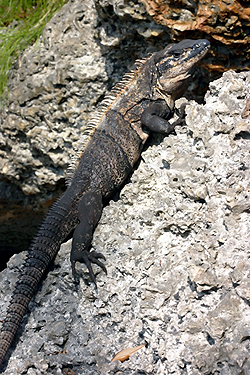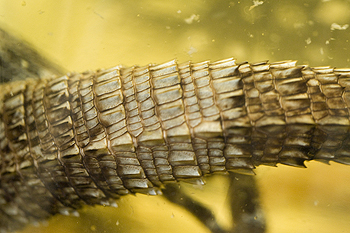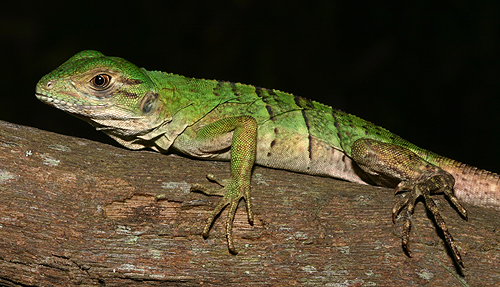
Photo by Kevin Enge
When it comes to invasive species in South Florida, the black spiny-tailed iguana, Ctenosaura similis, holds its own. The Central American native isn’t imported for the pet trade like the green iguana (Iguana iguana), but the species still has managed to spread far and wide, now numbering in the tens of thousands.
The black spiny-tailed iguana joins the green iguana and the Nile monitor, Varanus niloticus, as the three large, nonindigenous lizard species found throughout south Florida. It can be found along the southwest coast from Manatee (Tampa Bay) to Marco Island and along the east coast from Broward County down to No Name Key in the Lower Keys.
Researchers generally believe that non-native species are harmful to native plant and animal life, but those effects are difficult to document scientifically. A new study by Florida Museum of Natural History herpetologist Kenneth Krysko helps to address that shortcoming by investigating the black spiny-tailed iguana’s diet.
As it turns out, the iguana appears to eat just about anything and everything over the course of its life, including the endangered Curaçao bush, Cordia globosa, and the invasive Brazilian pepper, Schinus terebinthifolius, which it spreads through its scat.

Florida Museum photo by Jeff Gage
Understanding the diet of a non-indigenous species is important for understanding its ecological impact, Krysko said. Looking at diet helps explain competition, predation and life-history characteristics that help document ecological impact. Understanding the diet also helps with management of the species, Krysko said. If you know what they’re eating, you know which habitats they will prefer.
The study, published in the Winter 2009 issue of Florida Scientist, tests the hypothesis that C. similis makes a dietary shift as it develops, consuming mostly invertebrates as a juvenile and mostly vegetation as an adult.
As it turns out, the black spiny-tailed iguana appears to eat a little bit of everything. At different stages of its life, C. similis consumes leaves, flowers, fruit, insects, spiders, crabs, fish, rodents, hatchling sea turtles, lizards and their eggs, birds and their eggs, bats, and its own eggs and hatchlings.
Population growth
It takes only a few releases into the wild for a population of the iguanas to take hold. One female Ctenosaur can produce hundreds of offspring in her lifetime. Further, sperm within a female remains viable for years, allowing her to continue laying fertilized eggs in the absence of males.

Photo by Jeff Gage
The black spiny-tailed iguana gained a foothold in south Florida following multiple introductions from independent illegal releases, Krysko said. The iguanas like warm temperatures and sandy areas where they can burrow, making suburban lawns in south Florida an ideal habitat.
The study found that only two C. similis, one from each site, had consumed Brazilian pepper plants, Schinus terebinthifolius. But because the iguanas came from different sites, it suggests that consumption of this invasive plant might occur throughout the iguana’s range in south Florida. Other studies have also reported that C. similis consumes Brazilian pepper in Florida.
But iguanas aren’t the only animals that help spread Brazilian pepper. Raccoons have also proven to be quite adept at seed dispersal, Krysko said. That means that two very different animals, both of which are common in south Florida, play the same ecological role when it comes to dispersing Brazilian pepper. “And they’re doing a pretty good job,” he said.

Photo by Kevin Enge
Both Charlotte and Lee counties are spending tens of thousands of dollars to remove Brazilian pepper plants from the island, and the iguana’s role in dispersing the seed may disrupt these efforts.
While removing iguanas would benefit county managers who are trying to eliminate Brazilian pepper, that effort still doesn’t address the problem with raccoons, which are Florida natives. Even so, managers must try to remove all non-indigenous species, Krysko said. “You can’t let up on plants, you can’t let up on the Ctenosaura.”
The No. 1 goal is to completely eradicate the species, Krysko said. But since it’s likely too late to achieve that, management solutions must look at what effects the iguana has on the environment. Looking at its diet is one way to do that.
Unfortunately, the study shows that C. similis is an opportunistic species that will eat almost anything that’s available. And that, he said, makes the task all the more challenging.
Learn more about the Herpetology Collection at the Florida Museum.